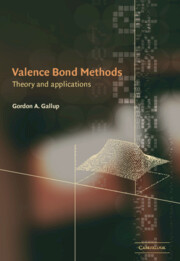Book contents
- Frontmatter
- Contents
- Preface
- List of abbreviations
- I Theory and two-electron systems
- II Examples and interpretations
- 9 Selection of structures and arrangement of bases
- 10 Four simple three-electron systems
- 11 Second row homonuclear diatomics
- 12 Second row heteronuclear diatomics
- 13 Methane, ethane and hybridization
- 14 Rings of hydrogen atoms
- 15 Aromatic compounds
- 16 Interaction of molecular fragments
- References
- Index
9 - Selection of structures and arrangement of bases
Published online by Cambridge University Press: 13 August 2009
- Frontmatter
- Contents
- Preface
- List of abbreviations
- I Theory and two-electron systems
- II Examples and interpretations
- 9 Selection of structures and arrangement of bases
- 10 Four simple three-electron systems
- 11 Second row homonuclear diatomics
- 12 Second row heteronuclear diatomics
- 13 Methane, ethane and hybridization
- 14 Rings of hydrogen atoms
- 15 Aromatic compounds
- 16 Interaction of molecular fragments
- References
- Index
Summary
Since, for any but the smallest of systems, a full VB calculation is out of the question, it is essential to devise a useful and systematic procedure for the arrangement of the bases and for the selection of a manageable subset of structures based upon these orbitals. These two problems are interrelated and cannot be discussed in complete isolation from one another, but we will consider the basis question first. In our two-electron calculations we have already addressed some of the issues, but here we look at the problems more systematically.
The AO bases
The calculations described in this section of the book have, for the most part, been carried out using three of the basis sets developed by the Pople school.
STO3G A minimal basis. This contains exactly the number of orbitals that might be occupied in each atomic shell.
6-31G A valence double-ζ basis. This basis has been constructed for atoms up through Ar.
6-31G* A valence double-ζ basis with polarization functions added. Polarization functions are functions of one larger l-value than normally occurs in an atomic shell in the ground state.
Any departures from these will be spelled out at the place they are used.
Our general procedure is to represent the atoms in a molecule using the Hartree–Fock orbitals of the individual atoms occurring in the molecule. (We will also consider the interaction of molecular fragments where the Hartree–Fock orbitals of the fragments are used.)
- Type
- Chapter
- Information
- Valence Bond MethodsTheory and Applications, pp. 121 - 124Publisher: Cambridge University PressPrint publication year: 2002



